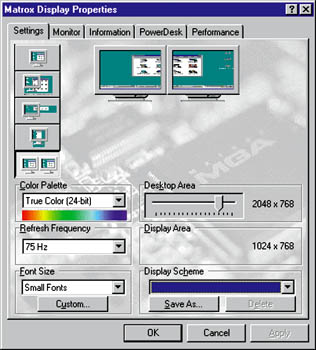
|
|
|
So you've taken up day-trading. You're also scrounging up MP3 files for the ultimate road-trip collection and updating your rotisserie football site. Meanwhile, you have to get some real work done. You need a second monitor. Windows 98 makes it fairly easy to spread your desktop over multiple displays, and, fortunately, graphics adapters and monitors are downright cheap these days. Alas, NT 4.0 is less flexible than Windows 98 in its handling of multiple displays (the latter allows you to mix and match as many as eight graphics adapters using standard drivers). Depending on which adapter is already installed on your system, however, you can add a second fairly easily.
The secret is to install two identical cards (see FIGURE 1), and download a driver that supports dual-display mode. Many dual-display drivers also require that you first install Service Pack 3 or later, something you should do anyway. (Download this from www.microsoft.com/windows/servicepacks.) Though a few vendors (ATI chief among them) have no dual-display drivers, most offer them for at least some of their adapters. Here are two leading offerings that work in dual-display mode with Windows NT 4.0: * Matrox (www.matrox.com/mga/drivers/home.htm): the Millennium, Millennium 2, Mystique, Mystique 220, Millennium G200, and the Productiva G100. * Number Nine (www.nine.com/support/drivers/rev3ddrv.html): the Imagine Series 2 (not the original Imagine 128) and the Revolution 3D. If installing a second card in your system is not appropriate (because you're tight on slots or because the card you already have doesn't support dual displays), you can still set up a dual-display system. The following single-card adapters support two displays under NT 4.0: * Diamond (www.diamondmm.com): FireGL 2000/3000 * Matrox (www.matrox.com): the Millennium G400, G400-TV * STB Systems (www.stbmvp.com/mvppro.htm): the MVP Pro Scott Spanbauer |
Category:Windows NT Issue: March 2000 |
These Web pages are produced by Australian PC World © 1999 IDG Communications
